Armed Caribbean. What are the armies of the Caribbean?
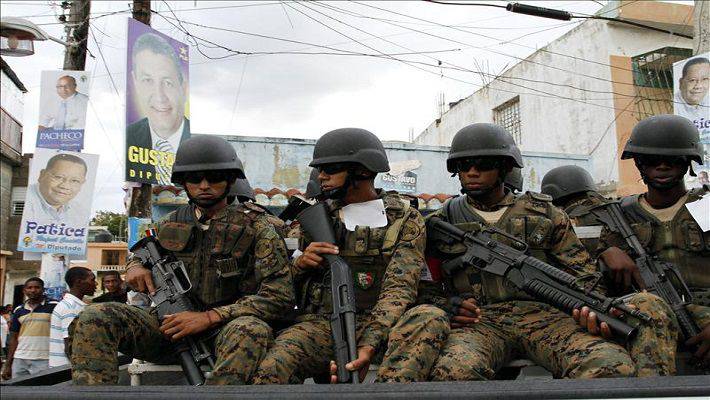
The largest army after Cuba
In 1821, the Spanish colony of Santo Domingo was able to achieve independence, but already in the next 1822, it came under the control of the neighboring Republic of Haiti and remained in its structure until 1844. In 1844, there was an uprising against the government of Haiti, as a result of which The eastern part of the island was proclaimed Dominican Republic. Since that time, the date of the official declaration of independence of the country is considered 27 February 1844 year. However, in 1861, Spain once again managed to seize the Dominican Republic and only four years later, in 1865, the Dominicans managed to finally get rid of the invaders. The history of the Dominican Republic is an endless series of military coups and uprisings, confrontations with neighboring Haiti and complex relationships with the United States of America. Given that the Dominican Republic has always remained a socially and economically backward country, popular unrest and uprisings periodically erupted here. This factor, as well as the persistent problems with a troubled neighbor, Haiti, necessitated the creation and maintenance of sufficiently numerous by the standards of the Caribbean countries, the armed forces. The army has always played a significant role in the political history of the Dominican Republic, where military junta of the classical Latin American type repeatedly came to power. The armed forces of the Dominican Republic in the first decades of its political independence were not distinguished by large numbers of personnel and, all the more, by good armament and equipment.
The number of armed forces of the country in the period of the “First Republic” was about 4000 soldiers and officers. The armed forces included 7 infantry regiments, several separate battalions, 6 cavalry squadrons and 3 artillery batteries. In addition, the country's guards were at the disposal of the Civil Guard, which was an analogue of the internal forces and serving in the provinces of the country, and the National Maritime Armada, which included 10 ships: 20-gun frigate Hibao, San Jose brigantine with 5 artillery tools; La Libertad schooner with 5 implements; schooner "Santana" with 7 implements; La Merced Schooner with 5 implements; schooner "Separazon" with 3 implements; schooner "February 27" with 5 implements; Maria Louise schooner with 3 implements; schooner "30 March" with 3 implements; Esperanza schooner with 3 guns. The National Maritime Armada served as a sailor and officer 674. Also in the Dominican Republic there was a military expeditionary corps, recruited by the first president of Pedro Santana in Ato Mayor and El-Seibo. This corps was armed with machetes and spears, and Brigadier General Antonio Duverger was directly in charge of the corps. On the northern borders of the republic was located the northern expeditionary force under the command of Major General Francisco Salcedo. In the early years of independence, the Dominican Republic spent on defense up to 55% of the country's national budget, which was associated with the constant military invasions of Haiti, which attempted to annex the eastern part of the island and subordinate the Dominican Republic to its authority.
The socio-economic and political weakness of the Dominican Republic led to the fact that by the beginning of the twentieth century. she fell into a strong economic dependence on the United States. 5 May 1916. American troops landed on the island and occupied the territory of the Dominican Republic. The consequence of the American military occupation, which lasted eight years - until 1924, was the elimination of the armed forces of the Dominican Republic. In 1917, in the second year of the occupation, the National Guard of the Dominican Republic was created. The US Marine Corps served as a model for its creation, instructors of which trained officers and soldiers of the Dominican Republic National Guard. In June, 1921, the military governor of Santo Domingo, Rear Admiral Thomas Snowden signed an order to reorganize the National Guard into the National Police. In 1924, the American military occupation of the country ended, and Horacio Vázquez won the presidential election, one of the first decrees of which was the transformation of the Dominican National Police into a National Army.
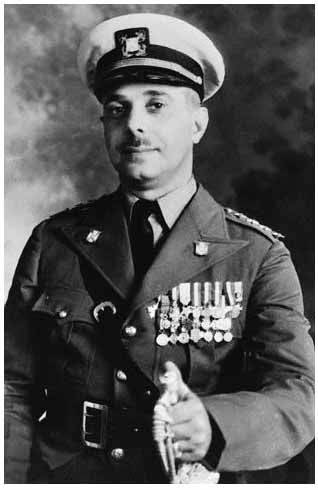 In February, a military coup took place in the Dominican Republic. General Rafael Leonidas Trujillo Molina (1930-1891), who was the commander-in-chief, seized power in the country. 1961 August 16. He was officially elected president of the country - 1930% of voters voted for Trujillo. Rafael Trujillo, a descendant of a poor family (his grandfather was a sergeant of the Spanish army), worked as a telegraph operator for three years, then he was fired and engaged in crime, pillaging and stealing cattle. Young Trujillo spent several months in prison, and then organized a gang of "99", which also hunted. After the American occupation, in 42, X-NUMX-year-old Trujillo joined the National Guard organized by the occupation regime and in nine years he rose from lieutenant to general. It was during the reign of Trujillo that the reorganization of the Dominican army began, which continued to perform mainly police functions. In 1918, the strength of the country's armed forces reached 27 officers and soldiers, including police officers. In 1937, the strength of the armed forces was 3839 soldiers and officers of the army and 1942 police officers. In 3500, the country’s air forces were established. The army became the main stronghold of Generalissimo Rafael Trujillo Molin, who established a tough dictatorship and was at the head of the state for more than thirty years - until 900, until he was killed as a result of a conspiracy by a group of representatives of the country's military and economic elite. One of the distinguishing features of the dictatorship of Generalissimo Trujillo was his anti-Haiti policy aimed at the deportation of Haitian refugees from the Dominican Republic. Despite the fact that the Dominican Republic itself remained a very economically unfavorable country, living conditions in Haiti were even worse, which stimulated the influx of refugees. In turn, Trujillo sought to reduce the percentage of the African population of the country, for which, on the one hand, he accepted any European migrants without any problems - both Spanish migrants and Jews who had fled from the fascist countries of Europe, and on the other hand - pursued a tough policy against the Haitian refugees. The Dominican army became the main instrument of Trujillo’s anti-Chinese policy. The political counterintelligence functions of the country engaged in repression against dissidents were performed by the Military Intelligence Service under the supervision of Johnny Arbens García (1948-1961), a former sports reporter who entered Trujillo’s service.
In February, a military coup took place in the Dominican Republic. General Rafael Leonidas Trujillo Molina (1930-1891), who was the commander-in-chief, seized power in the country. 1961 August 16. He was officially elected president of the country - 1930% of voters voted for Trujillo. Rafael Trujillo, a descendant of a poor family (his grandfather was a sergeant of the Spanish army), worked as a telegraph operator for three years, then he was fired and engaged in crime, pillaging and stealing cattle. Young Trujillo spent several months in prison, and then organized a gang of "99", which also hunted. After the American occupation, in 42, X-NUMX-year-old Trujillo joined the National Guard organized by the occupation regime and in nine years he rose from lieutenant to general. It was during the reign of Trujillo that the reorganization of the Dominican army began, which continued to perform mainly police functions. In 1918, the strength of the country's armed forces reached 27 officers and soldiers, including police officers. In 1937, the strength of the armed forces was 3839 soldiers and officers of the army and 1942 police officers. In 3500, the country’s air forces were established. The army became the main stronghold of Generalissimo Rafael Trujillo Molin, who established a tough dictatorship and was at the head of the state for more than thirty years - until 900, until he was killed as a result of a conspiracy by a group of representatives of the country's military and economic elite. One of the distinguishing features of the dictatorship of Generalissimo Trujillo was his anti-Haiti policy aimed at the deportation of Haitian refugees from the Dominican Republic. Despite the fact that the Dominican Republic itself remained a very economically unfavorable country, living conditions in Haiti were even worse, which stimulated the influx of refugees. In turn, Trujillo sought to reduce the percentage of the African population of the country, for which, on the one hand, he accepted any European migrants without any problems - both Spanish migrants and Jews who had fled from the fascist countries of Europe, and on the other hand - pursued a tough policy against the Haitian refugees. The Dominican army became the main instrument of Trujillo’s anti-Chinese policy. The political counterintelligence functions of the country engaged in repression against dissidents were performed by the Military Intelligence Service under the supervision of Johnny Arbens García (1948-1961), a former sports reporter who entered Trujillo’s service. The Dominican Republic's armed forces currently number 64 and are composed of ground forces, the air force and the navy fleet. The ground forces of the Dominican Republic have 45 soldiers and officers. They include 800 infantry brigades, an auxiliary brigade and aviation squadron. The country's air force is based on two air bases in the north and south of the country, respectively. Their number is 5 officers and soldiers. The DR Air Force has 498 aircraft and helicopters. The history of the Air Force of the Dominican Republic began in 43, when a national aviation unit was formed in the army. However, until 1932, the country was able to acquire only about ten aircraft. In 1942, aviation received the name of the aviation company of the national army. After a group of political opponents Trujillo tried to invade the republic from Cuban territory in 1942, the president ordered the purchase of bombers and fighters from the United States. But the United States refused to sell aircraft. Then Trujillo acquired it in the UK. Then, after the signing of the Rio 1947 Treaty, the republic received 1947 fighter-bombers and 25 training aircraft from the United States. After that, the aviation company was transformed into an independent type of armed forces and renamed the Military Aviation Corps of the Dominican Republic. Since 30, military aviation was named the Air Force of the Dominican Republic. The Navy of the Dominican Republic is armed with 1962 warships, 3 boats and 25 patrol helicopters. The number of personnel of the Navy reaches 2 officers and sailors. As before, the armed forces of the country mainly carry out police functions, actively participating in the fight against drug trafficking in the Caribbean, smuggling and illegal migration from Haiti to the Dominican Republic and from the Dominican Republic to the United States.
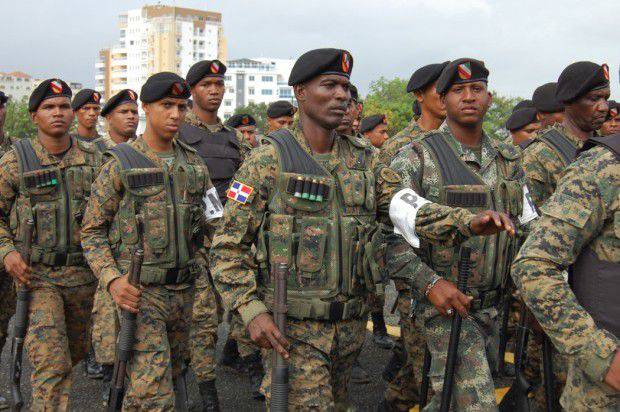
Recruitment of the armed forces of the Dominican Republic is carried out by hiring for military service under a contract of citizens of the country. Requirements are citizens aged 16-45 years. The officers of the armed forces are trained in the Military Academy, the Air Academy and the Naval Academy, as well as in the US military educational institutions. At the Military Academy, the course is designed for the 4 of the year and the 3 of the month. Upon graduation, graduates receive a bachelor's degree in military sciences. At the Naval Academy, the training period is 4 of the year, at the Air Academy - also 4 of the year in three specialties - aviation maintenance, ground handling and maintenance of aircraft. The following military ranks are established in the army and navy of the country: 1) Lieutenant General (Admiral), 2) Major General (Vice Admiral), 3) Brigadier General (Rear Admiral), 4) Colonel (Fleet Captain), 5 ) Colonel (captain frigate), 6) Major (captain corvette), 7) captain (Lt. Navy), 8) first Lt. (Lt. frigate), 9) second Lt. (Lt. corvette), 10) cadet (midshipman), 11) sergeant major, 12) first sergeant, 13) headquarters sergeant, 14) sergeant, 15) corporal, 16) private first class (first class sailor), 17) private (matr c). In accordance with the Constitution of the Dominican Republic, the commander-in-chief of the armed forces is the president of the country. He leads the armed forces through the minister of the armed forces and the commanders of the army, navy and air force. The Minister and his deputies are military personnel. The Minister of the Armed Forces is appointed by the President, and the Minister in turn, with the approval of the President, appoints his deputies. As a rule, the Minister of the Armed Forces of the country carries the rank of Lieutenant General (or Admiral - if he is a naval officer). Currently (since 2014), the Minister of the Armed Forces of the country is Lieutenant-General Maksimo Munoz Delgado. Each type of armed forces has its own headquarters. The Dominican Republic is divided into three defense zones - the military district. The South defense zone has a center in Santo Domingo, the North defense zone in Santiago de los Caballeros, the West defense zone in Barahona. In addition to the military units themselves, within the Ministry of the Armed Forces, there are military security agencies, made up of military personnel and civilian personnel, which perform extensive functions in the field of national security. These include: the Anti-Terrorism Command of the Dominican Armed Forces, the Department of National Studies, the Airport Security and Civil Aviation Security Specialized Corps, the Metro Special Security Corps, the National Environmental Protection Service, the Tourist Security Specialized Corps, the Special Port Security Service, the Land Security Special Service.
Haiti: the army is dissolved, its functions are performed by the police
Until the beginning of the 1990's. located in the western part of the island of Haiti, the eponymous Republic of Haiti also possessed sufficiently numerous by Caribbean standards armed forces. Their story began at the end of the 18th century in the process of a heavy armed struggle for national independence. The ten-year war of independence not only contributed to the formation of the Haitian army, but also advanced from the environment of the former African slaves - blacks and mulattoes - warlords, who played a crucial role in the political history of the country. For two centuries, the armed forces were the main instrument of political governance in the country. The need for increased military spending was due to constant rivalry with the neighboring Dominican Republic. But political instability in Haiti itself led to a weakening of the armed forces. At the end of the 19th century, the Haitian army was an undisciplined and poorly paid militia, divided into detachments devoted not so much to the country as to their commanders. At the beginning of the twentieth century. The Haitian army consisted of 9000 soldiers and officers, 308 generals. In 1915, Haiti was occupied by the United States of America, after which the former Haitian army was disbanded. In February, 1916 was formed by the Gendarmerie of Haiti, with the participation of the American marines. Initially, the detachments of the Haitian gendarmes were commanded by officers and sergeants of the American marines. The function of the gendarmerie was to ensure public order, in addition, it was charged with the responsibility to ensure the implementation of orders of the American command. In 1928, the Haitian Guard was created on the basis of the Gendarmerie of Haiti, which formed the core of the country's armed forces after the end of the American military occupation in 1934. The United States sought to create a modern army in Haiti that could provide defense and internal order in the country. Therefore, the preparation of the Guard of Haiti was also carried out by American officers and sergeants. But almost immediately after the end of the period of the American occupation, the political situation in the country escalated. The military again took over the functions of government in the absence of any other force capable of restoring order in the country.
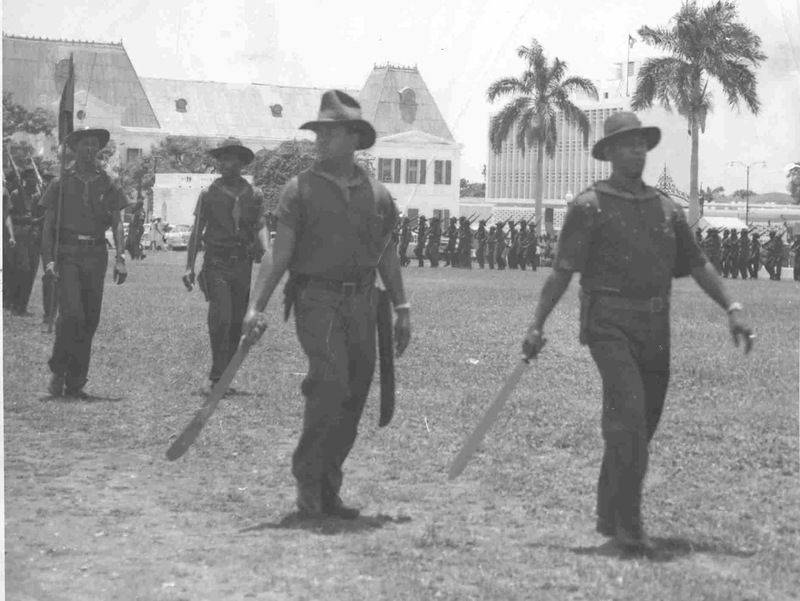
When in 1957 The dictator Francois Duvalier came to power in Haiti, he tried to neutralize the influence of the military elite on the political life of the country, relying on the paramilitary forces controlled by him personally. Duvalier retired most of the senior officers of the Haitian army, who were still trained by American instructors during the occupation period. Duvalier was under the personal control of the presidential guard and formed in 1959. civilian police are the very “Taunton of Makuta”, which became widely known for their reprisals against opponents of the regime. Civilian militia personnel were recruited from among the young lumpen inhabitants of the slums of Port-au-Prince and other cities in the country. In 1961 was Duvalier closed the Military Academy, seeking to weaken the position of the army and prevent the possibility of replenishing the officer corps. Duvalier’s next step was the expulsion of American instructors to 1963, since the dictator saw in their training for the Haitian army a potential danger to their power. However, discontent with the Duvalier regime was also expressed by employees of the militias created by him. Thus, 1967 g 19 officers of the presidential guard were executed on charges of organizing explosions near the presidential palace. The situation began to change in 1971, when Jean-Claude Duvalier came to power in the country, seeking to modernize the defense and security system of the Haitian state. He included a number of commanders of paramilitary formations in the army officer corps. In 1972 was The Haiti Military Academy was reopened. However, the army did not defend Duvalier Junior, which collapsed in 1986. The troops refused to shoot at opposition demonstrations, there were also cases of unrest among the soldiers. However, at the end of 1980's. The Haitian army continued to perform primarily police functions. After the overthrow of the Duvalier regime, the role of the military in Haiti increased significantly. Only in 1988 Four military coups took place, and in 1989 - the fifth military coup. In the army itself, there was growing discontent with the junior officers and non-commissioned officers at the level of wages and the provision of servicemen. At the same time, during this period, a distinctive feature of the armed forces was a high degree of corruption and complicity in the drug trade. The lack of a professional police force in Haiti made it much more difficult to fight crime. Ultimately, in 1995 Haiti disbanded its armed forces. Peacekeeping units of the United States, France, Canada and Chile were deployed in Haiti, which helped stabilize the political situation in the country. In 2005 was It was the UN peacekeeping forces that conducted a series of operations against armed criminal gangs in Port-au-Prince. During this period, Brazilian military personnel played a major role in UN operations, whose numbers in the UN contingent in Haiti increased to 1200 people. Currently, the Haitian armed forces exist only on paper.
The Coast Guard Commissariat of Haiti is one of the few police departments in the world that are focused on both the coast guard and the maritime police. In addition, the Haitian Coast Guard also serves as a rescue service. The history of the coast guard of Haiti began at the end of the 1930s, when two boats entered its armament. During World War II, six 83-foot boats were sent to the Coast Guard, followed by several other patrol boats handed over to the US Coast Guard. At 1948, a US Navy mission arrived in Haiti. Since then, the United States has provided substantial assistance in equipping and training the staff of the Haitian coast guard. In 1970, coast guard troops attempted an armed insurgency. Three ships of the Coast Guard fired at the Duvalier Presidential Palace in Port-au-Prince, but they managed to drive them away with the help of aviation. The ships surrendered to American soldiers from Guantanamo base, after which they were disarmed and transferred back to Haiti. After this incident, Duvalier renamed the coast guard to the Haitian fleet. In 1976, Haiti acquired five small patrol vessels in the state of Louisiana. By the end of 1980's The Haitian fleet was armed with the Henri Christophe tugboat, American-made 9 small patrol ships and the old San Sushi presidential yacht. 45 officers and 280 sailors served in the navy. After the disbanding of the Haitian armed forces, the remnants of the fleet were renamed the coast guard and transferred to the operational control of the Haitian national police. Currently, the Coast Guard Corps of Haiti performs tasks to ensure the protection of the territorial waters of the country, the fight against drug trafficking, all types of crime, compliance with laws and regulations in the field of shipping and fishing. The coast guard consists of: a command post as part of the coast guard commandant, his assistant, operational manager; three coast guard bases in Port-au-Prince, Cap-Antienne and Jacmel. The Coast Guard is armed with 12 ships of the Vedette type and 7 patrol boats.
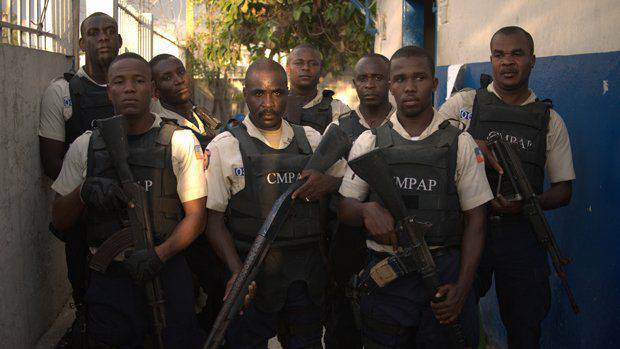
The Haitian National Police currently performs a full range of functions related not only to the fight against crime and the protection of public order, but also to ensuring the national security and defense of the country. The National Police was created in 1995. Since then, more than 8500 police officers have been trained by American, Canadian, Brazilian, Argentinean, Chilean and French instructors. It is currently planned to increase the number of police in Haiti to 14 000 people. A significant role in the Haitian police is played by former soldiers of the army disbanded in 1995, some of which insist on the revival of the country's armed forces. Currently, the Haitian National Police is headed by a police commissioner appointed by the President for a four-year term. The Haitian National Police consists of the following structural units: 1) Directorate General of the National Police of Haiti, 2) General Inspectorate of the National Police of Haiti, 3) Supplementary Information Directorate, 4) Administrative Directorate. The police are tasked with ensuring public safety, protecting people and their property, protecting state institutions, protecting public order and peace in the country, licensing the right to firearms. weapons. Also in the National Police of Haiti is the judicial police, which serves as the criminal investigation and investigation services. The police were initially recruited through the recruitment of former members of the Haitian army. Currently, the National Police Academy is trained by the Haitian Police Academy, founded in 1994.
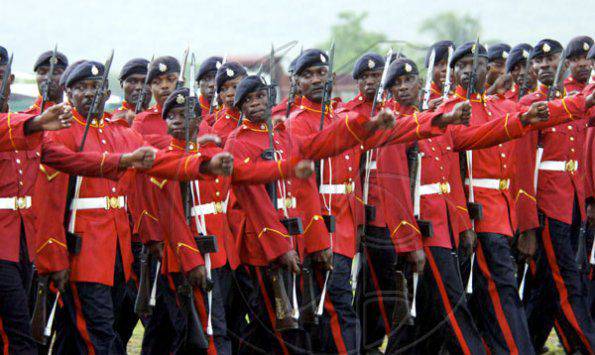
Jamaica Defense Forces
Unlike the armed forces of the Dominican Republic and Haiti, the paramilitaries of a number of other Caribbean states have their origins not in the struggle for independence, but in the history of the colonial forces and the police. Jamaica, a former British colony, is one of the most battle-worthy militias. The Jamaica Defense Forces include an army, an air wing and a coast guard. The training, organizational structure, weapons and traditions of the Jamaican armed forces inherit the experience of the British military model. It was the United Kingdom, as well as Canada and the United States, that played the main role in ensuring the creation of its own armed forces in Jamaica. The Jamaica Defense Forces are the heir to the traditions of the British West Indies regiment who served in the British colonies in the Caribbean. The West Indies Regiment existed from 1795 to 1926, then was transformed into the Jamaican voluntary infantry during the Second World War. Currently, the Jamaica Defense Forces include an infantry regiment, a reserve corps, an engineering unit, an aviation wing and a coast guard fleet. The infantry regiment includes the 3 Infantry Battalion. The wing includes a training unit, a base, and the wing directly. The Coast Guard includes sea crews and support and support crews. Among the functions that the Jamaica Defense Forces perform, they include not only the defense of the maritime frontiers of the country, but also assistance to the police in the fight against drug trafficking, smuggling and street crime. The members of the Defense Forces, along with the police, are involved in patrolling Jamaican cities and fighting criminal groups active in urban slums. Currently, the strength of the Jamaica Defense Forces reaches 2 830 military personnel. In the ground units - the Jamaican Infantry Regiment and Engineering Regiment - 2 500 people are serving. In service are 4 armored personnel carriers and 12 mortars. In the aviation wing, 140 soldiers and officers serve; 1 transport aircraft, 3 light aircraft and 8 helicopters are in service. The coast guard serves 190 people, armed with 3 speedboats and 8 patrol boats.
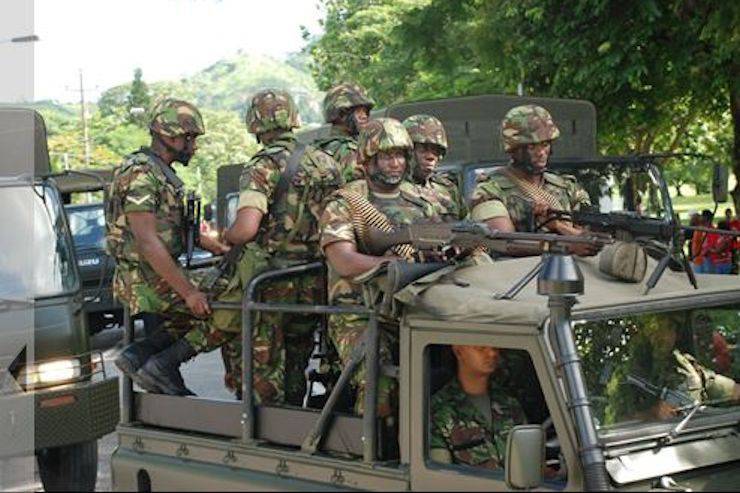
Trinidad Army - Third in the West Indies
Another former British colony in the West Indies, Trinidad and Tobago, has a greater military potential than Jamaica. The history of the armed forces of this country goes back to the combat path of the 2 battalion of the British West Indies regiment, on the basis of which the formation of the Trinidad and Tobago Defense Forces began in 1962. Currently, the strength of the Trinidad and Tobago Defense Forces is reaching 4. 000 is one of the largest armed forces in the Caribbean (after Cuba and the Dominican Republic, as well as the Haitian police). The ground troops of Trinidad and Tobago have about 3 000 troops and include the Trinidad Infantry Regiment and a battalion of support and support. The Trinidad Infantry Regiment is the heir to the 2 Battalion of the West Indies Regiment of British colonial troops. Despite the status of the regiment, in fact it is an infantry brigade of 2800 soldiers and officers. The regiment consists of the 2 infantry battalion, the 1 engineering battalion and the 1 support battalion. The ground forces are armed with 6 mortars, 24 recoilless guns and 13 grenade launchers. The Coast Guard of Trinidad and Tobago has an 1063 officer and sailor and includes the 1 patrol ship, the 2 large and 17 small patrol boats, the 1 auxiliary ship, and the 5 aircraft. The air guard of Trinidad and Tobago was established in 1966 as part of the coast guard, but in 1977, after 11 years after its creation, it was allocated to a separate type of national defense force. The Trinidad Air Force is armed with 10 aircraft and a 4 helicopter. The defense forces of Trinidad and Tobago perform tasks to ensure internal security, the fight against crime, drug trafficking and smuggling. In 1993-1996 Trinidadian soldiers performed peacekeeping functions in Haiti as part of the UN peacekeeping contingent, and in 2004-2005 they participated in the aftermath of the terrible hurricane in another small island nation, Grenada.
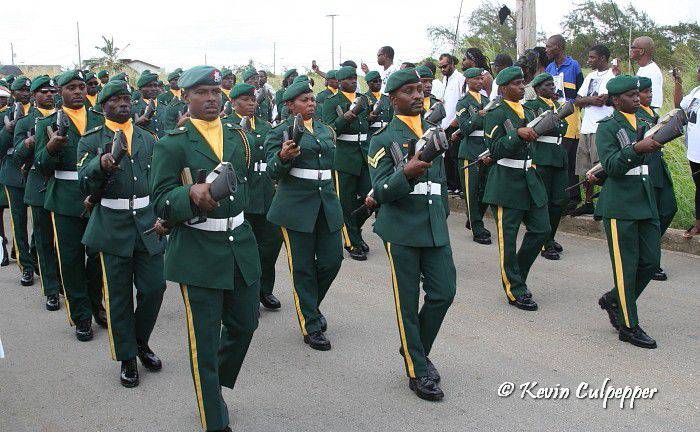
Barbados Defense Forces
Another former British colony in the Caribbean with its own armed forces is Barbados. The Barbados Defense Forces, created by 15 August 1979, include three main components - the Barbados Regiment, the Coast Guard and the Cadet Corps. The headquarters of the Defense Forces of Barbados is in Fort St. Anne. The command of the Defense Forces is carried out by the Chief of Staff (currently, this post is occupied by Colonel Alvin Quentin). The Barbados Regiment is the historic heir to the Barbados Volunteer Forces, created in the colonial era - in 1902, to protect the island and maintain order after the withdrawal of the main contingent of British troops. Barbados military personnel participated in the First and Second World Wars as part of the West Indies and Caribbean Regiments. In 1948, the Barbados Regiment was established on the basis of the Barbados Volunteer Forces, which then became the basis of the Barbados Defense Forces (in 1959-1962, during the existence of the Federation of the West Indies, the regiment was part of its third battalion). Currently, the regiment is based at Fort St. Anne, commanded by Lieutenant Colonel Glen Grannum. The Barbadoskiy regiment consists of the 2 battalion - a regular battalion (the composition is a staff company, an engineering company, a company of special operations) and a reserve battalion (composition - a company company and 2 rifle companies). The regiment also included the military orchestra of the Barbados Defense Forces, whose musicians still “flaunt” in the uniform of a sample of the West Indies regiment of the second half of the XIX century. The Barbados Coast Guard is based on the Pelican base and is engaged in the protection of the country's territorial waters, the fight against drug trafficking, humanitarian and rescue operations. The number of Barbados Coast Guard is about 150 officers and sailors. The command of the coast guard is exercised by the commander - currently Lieutenant Peterson. The Barbados Cadet Corps is a militarized youth organization founded back in 1904. The corps consists of infantry and naval cadets, a medical unit. The corps is commanded by the commander - currently this position is occupied by Lieutenant Colonel James Bradshaw. In addition, the internal security function in Barbados is performed by the Royal Barbados Police, established in 1961 following the pattern of the London police.
The defense of the "smallest"
The Dominican Republic, Trinidad and Tobago, Jamaica and Barbados possess the largest armed forces in the Caribbean (with the exception of Cuba). But a number of small island states have their own defense forces and police formations. The Royal Antigua and Barbuda Defense Forces total 245 people. They include: headquarters service, an engineering platoon, an infantry company, a coast guard fleet of several boats. But despite its small size, the Antigua and Barbuda Defense Forces participated in a number of armed operations in the West Indies: the landing of American troops in Grenada in 1983, the suppression of the insurgency in Trinidad in 1990, the peacekeeping operation in Haiti in 1995. The main functions of the Antigua and Barbuda Defense Forces are to ensure internal security, safeguard public order, fight crime and drug trafficking, control fishing, rescue and environmental protection.
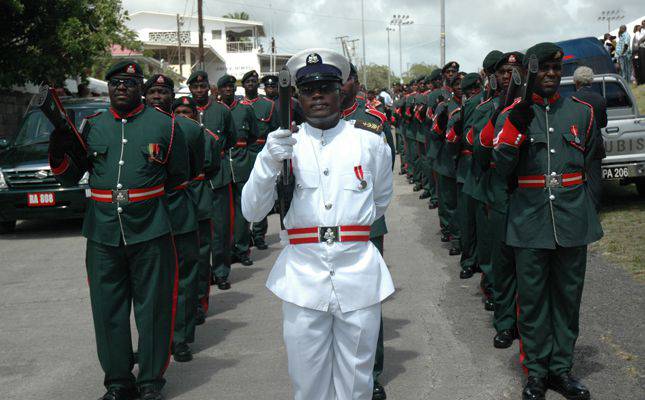
Saint Kitts and Nevis also has its own Defense Forces (parade in the photo). They were created in 1896 as a detachment to protect the order on sugarcane plantations. Currently, their numbers reach 300 people. The St. Kitts and Nevis Defense Forces include the St. Kitts and Nevis Regiment, the Coast Guard and the Cadet Corps. The regiment is in fact similar to an infantry company and consists of a platoon of command and three rifle platoons. In the Cadet Corps 150, young citizens of the country undergo military training. In St. Vincent and the Grenadines, there is the Royal Police of St. Vincent and the Grenadines, founded in 1999. The police include a 691 police officer and a civil servant. The paramilitary units of the royal police are the Special Service and Coast Guard. The Saint Lucia Royal Police Force operates in Saint Lucia, with 947 police and civilian personnel. The paramilitary components of the royal police force of Saint Lucia are also the coast guard and special forces unit.
Bahamas: Fleet Guard Country
In the Bahamas, due to their geographic location, there are no ground forces and air forces. But the country has its own Royal Bahamas Defense Forces, which consist of a navy that performs general functions for the protection of the state, its territorial integrity, public order and internal security, and the fight against crime. The Royal Bahamas Defense Forces were created on March 31 on 1980 as part of the Bahamas Ministry of National Security. The commander-in-chief is officially considered to be the monarch of Great Britain (now Queen Elizabeth II). The Royal Bahamas Defense Forces are the largest Navy of the Commonwealth countries in the Caribbean. Their number - about 1000 officers and sailors. The Royal Bahamas Defense Forces include naval crews and a commando squadron that performs the functions of the marines. The number of commando squadrons is about 500 military personnel undergoing training under the guidance of instructors of the British and American marines. In the Royal Bahamas defense forces established military ranks, similar to the military ranks of the British Royal Navy.
Thus, we see that the overwhelming majority of the Caribbean countries do not have any significant military capabilities and use their armed forces, even if they are, as internal troops and border guards. In case of serious military conflicts, they are counting on the intervention of their patrons - the United States or Great Britain.
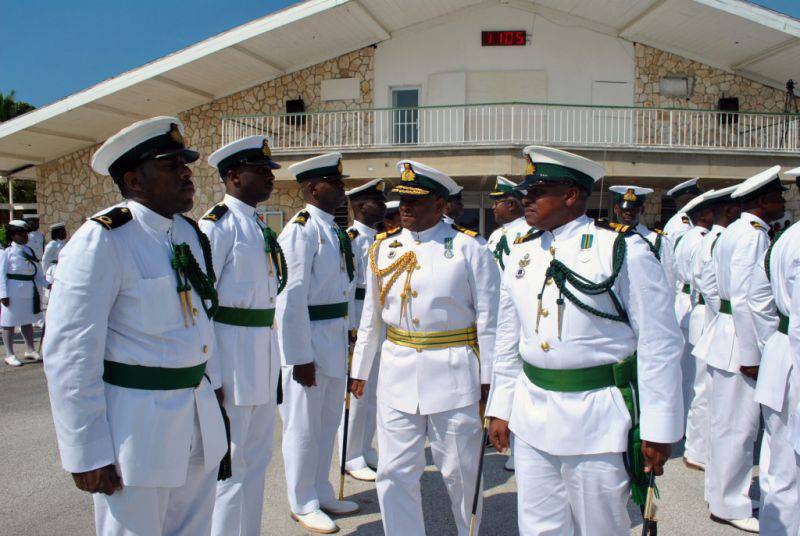
Information